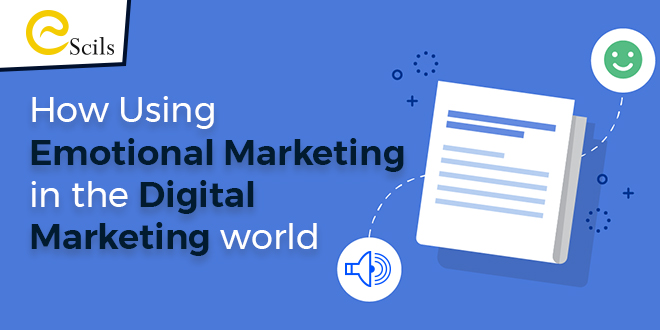“Emotion is a necessary ingredient to almost all decisions.”
Every choice that your customer makes consists of several conscious and subconscious emotional triggers.

Most people believe that the decisions they take the result from a rational analysis of available options. In reality, though, sentiments are the main element in the entire decision-making process. Now, there are several emotional triggers that you can use to increase your revenue while acquiring and emphasizing customer loyalty dramatically.
This post looks at the most common emotional triggers and shares some tactics and strategies to employ in your own marketing regime.

What is Emotional Marketing?
Emotional marketing is a marketing strategy that utilizes raw emotions like happiness, sadness, or anger to bring about a customer response. This can, in turn, lead to more social sharing and buying of the said marketed product. Not only that, but you will be paving your way towards customer loyalty. As trust builds between your brand and the users along with a better customer experience.
You see, fundamentally, emotional marketing connects with people at the very heart of their feelings.
Whatever the message may be, whether it uses positive emotions like satisfaction or joy or negative emotions like anger or disgust, it holds power to move people to respond emotionally.
And when people act solely out of emotions, they don’t use logical thinking that might otherwise prevent them from sharing or purchasing a product, which means a rise in your sales.
Emotional marketing can occur anywhere in your digital marketing platform, from your social media posts down to writing your product descriptions. You can use emotions to elicit certain behavior from your customers every step of the way.
Before we get into how to create an emotional marketing strategy, let’s first look into how emotions work.

What Emotional Marketing Really Does?
Most marketing articles claim that there are only 4 raw emotions that you can work with within any marketing message.This is not true, though. There are about 30 identified emotions that humans experience on a minute-by-minute basis. They mostly stem from these four core groups of emotions: happiness, sadness, fear, and anger.
You see, human beings are known to experience at least one emotion 90% of the time. They are basically a part of our living system.
Hence creating a content marketing strategy that pokes into human emotions is an excellent idea. Luckily for you, marketing teams have already done ample research, studied and learned a few things that you can easily integrate into your own marketing campaigns.
Positive Emotions Get More Shares
Now before you start marketing your respective product or service, you first need to establish trust among your audience.You can achieve this by doing some ‘brand awareness’ in which you, using a certain respective way, get your brand in front of them.
And social media provides an endless audience. So with the right content, you can expand your reach tenfold. If that’s what you want, you can create a few campaigns focusing on positive emotions, such as happiness and joy. Not only sticking to the basics. Content preaching about topics such as appreciation or other psychological needs is also known to attract an audience as these generally are subjects that many people can relate to emotionally. And we are no strangers to the fact that emotionally positive content holds the medal of being the most shared content and hence being the one to spread the fastest than any other content via social sharing.

Negative Posts Get More Views
Another one of the many branding strategies that many companies use is the utilization of negative emotions like sadness. As sadness is a human emotion that naturally brings people together for support, we can use this sentiment to arouse interest in others and have them more or less gather around for support.
Now by posting content that brings about an emotional response of sadness, you are likely to gain more clicks and engagement in the form of likes and comments on the very post as people naturally get curious about it.
Even though it’s not advisable to create entire emotional marketing campaigns centered on sadness, it is still a useful approach when you’re looking for more clicks on your content.
Loyalty In Times of Shock And Fear
On experiencing negative sentiments, such as fear, we unsurprisingly look for comfort and hope. Surprisingly though, people feel more loyal to a present brand during daunting times than to brands that were present during a good situation. For example, in movies, a brand or logo that was present during a scary event is more remembered and revered by people than the logo present at joyous or happy occasions.
While this marketing strategy counts as powerful but is not necessarily a good fit for all, after all, it doesn’t make sense for a brand to always frighten its target audience.
Aggressive Content = Viral Content
Many marketers shy away from the use of aggressive content like anger and disgust in their emotional marketing strategy. Unlike happiness and sadness, which usually just plays a bit with the hearts of the audience, anger and disgust can evoke a strong emotional response from the viewer that often turns into actual action, like sharing, forwarding, or commenting on the piece of content.
The caution here, this does not mean that you should purposefully upset your reader or provoke your target audience with provocative comments, though. Instead, choose a controversial topic related to your niche that already garners emotional reactions from people.
For instance, environmentally conscious brands might share factual content about the destructive consequence that a single-use of plastic has on our soil and water in hopes of provoking strong emotional reactions in their target audience.
Now when you approach these topics at an emotional level, you’re more likely to get an emotional response, leading to more virality.
Marketing Strategies To Evoke Emotions
Okay, so now that we have talked about the effect, certain emotions can have on marketing and all. Let’s discuss how we can use this stimulus actually to increase our sales.
Focus On Visuals
Now we have come to know that emotions have great importance to effective neuro-marketing because of their subliminal influence. You see almost 50% of the brain works as a visual processing power. So pay attention to your visual identity and logos, fonts, colors, depth, and movement to optimize for positive emotional experiences.
Personalize Your Interactions
Appeal to the human brain’s self-serving nature by making your customers feel happy, satisfied, and important. By making your exchanges with them feel exclusive as well as heartfelt. Fashion alternatives for customization and use targeted sales and marketing tactics to form interactions that feel like they’re tailored to meet every individual customer’s needs.
Keep Engaging With Users
Some other tips that can help elicit emotional reactions constitute engaging with your users and making them feel as if they are personally connected to your brand. You can do this by interacting with influencers, posting user-related content on social media, and replying to reviews and comments.
Respond to Public Relations Issues Quickly
When it comes to responding to large issues, one thing to always keep in mind is that “Timing is key,” and consumers appreciate a quick response when companies make a mistake.
Time to Get Emotional With Your Branding
Another word of advice that follows is always staying in touch with your user’s reactions, taking customer reviews and feedback seriously, and showing them you care for them by doing what is necessary.
You see, things like choosing colors, fonts, messages, and your business’s overall look won’t be complicated if you’re considerate enough and actually pay attention to your users’ reactions. This creates a connection based on trust, which can, in turn, create loyal, life-long brand ambassadors for your business

Emotional Branding
The development of the meaningful relationship between your brand and potential buyers by evoking certain emotions comes under the name of emotional marketing. We can see its examples in brands like Nike, which uses positive feelings of awe and inspiration in its Ads.
Remember that famous campaign of Nike’s “Just Do it”?. It is a perfect example of the emotional trigger of cultural leadership, and as consumers mostly want to be the first to try new products or services. Brand promotions making use of the emotional trigger related to leadership let their customers feel like they are the first ones for this audience.
Building emotional meaning into your brand allows you to create a lasting reaction that is deeply intertwined with your brand. This eventually influences buying decisions, like choosing you over your competitors.
Emotional Advertising
Emotional advertising is related to the kinds of advertisements placed by the company to evoke emotions, raise awareness around their brand, and build trust with their audience. For example, the World Wildlife Fund utilizes fear and alarm in advertisements to raise awareness about the harmful effects of global warming.
Another example is of Airbnb. They launched their “Let’s Keep Traveling Forward” campaign following the 2018 US travel ban. It’s evident by the very name of the campaign that their strategy was to catch the hearts of travel lovers. This specific marketing message certainly speaks to its target audience at an emotional level that helps promote trust and even brand loyalty.
Storytelling
The tactic that utilizes all, including marketing goals and customer loyalty, is storytelling. You see, storytelling is an art that has been around ever since the human race appeared, really. It is a craft as much essential for survival as anything else. After all, if you accurately portray a valuable lesson that will not be forgotten for generations, then your children will be better for it. So being able to tell a story and a good one at that, not only helps you connect on an emotional level but also helps others remember your story, and for what we are concerned, brand for a long time. Think about it yourself for a minute; when looking at other mediocre level ads, how many times do you strike up a conversation with a person nearby of a particular well made Ad and suddenly talk about its products? .We do this a lot and without much thought. The point is we remember it due to its creativity. The goal of storytelling is to be so good at it that the customers remember your brand when they are in the decision-making process just before purchasing a product.
#P&G “Thank You, Mom – Strong”
This highly sentimental piece of advertisement was released for the 2016 Rio-O Olympics. Created by P&G, this Ad significantly highlighted the noble role of a mother in our lives how she helps and teaches us and is always there for us. In this video, we watch Olympic athletes remember how their mothers encouraged them, comforted and reassured them as children, which helped them have the courage to compete in the Olympics.
P&G is a company that sells a wide range of products mostly meant for the home, so it’s a decisive move to do a bit of emotional branding on the home aspect of their company just as millions of people sit down to watch their commercial from home.

Bottom Line
An old expression concerning emotional marketing goes, “people buy emotionally, then justify logically.”
As already mentioned and proven many times in the article mentioned above, using sentiments in your ads and other marketing tactics can and will drive more sales. Irrespective of your choice of emotion, as long as you know the right way to execute and utilize it, the game will always play out in your favor.
I hope the examples and advice mentioned above will help you motivate your customers to take action and let you increase your marketing sales.


